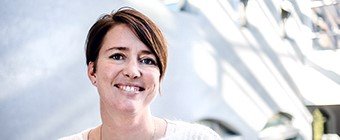ENVIRONMENTAL REQUIREMENTS HAVE ENTERED THE DIGITAL DESIGN MODEL
13.08.19
Integrating environmental requirements into digital project design work increases the likelihood of delivering climate-friendly solutions. COWI is doing the integration for the first time as part of a pilot project in Norway. The integration paves the way to an even more advanced BIM modelling, where sustainability plays a bigger part than ever.
How can we make sure that environmental aspects are considered at the very beginning of a design phase, before the actual construction begins?
This was one of the questions raised by the Rana Municipality in Norway, when entering the early planning stage for Gruben primary school.
They asked COWI for assistance and for the first time, environmental requirements for the consumption of materials have been incorporated into the Building Information Modelling (BIM) application.
“A sustainable building process has been on the agenda for a long time, and we have made a good start on integrating the environmental requirements into BIM. The contractors can already make use of the BIM model. Because COWI and the architects use different software, it was a challenge to import all requirements, but we are now arriving at a solution,” says Hilde Ramfjord, COWI’s BIM coordinator for the project.
STRONG BIM ORGANISATION
The results were achieved in close collaboration with the architects at SPINN arkitekter and the project design manager from Norconsult, as well as the project manager for the municipality of Rana.
Ramfjord says that they “cracked the code” thanks to an established BIM organisation, programming innovation and a forward-looking client.
“COWI has a strong BIM organisation in which the various technical disciplines are represented – now including environmental issues and software development. This provides for solid cross-project teamwork with scope for innovation. Areas like fire safety and acoustics have had well established BIM working methods for several years, so we used the experience from these areas to develop our own application, which offers us fresh opportunities within BIM,” says Ramfjord.
“We also have a very environmentally aware and ambitious client, who is anxious to digitalise as much as possible and to test new solutions. This has also advanced our innovation work,” she says.
The application calculates environmental requirements for the consumption of materials in the Building Information Modelling (BIM) project design tool. From the left: Vibeke Nossum, Bente Veiåker Engmo and Hilde Ramfjord, COWI (Photo: Hans-Einar Råberg)
WATCHDOGS FROM DAY ONE
Rana municipality has been focusing on the environment right from the early planning stage for Gruben primary school.
Bente Veiåker Engmo, COWI’s environmental consultant on the project, explains that environmental consultants quickly became involved in the project design.
“That way, we were able to get on board and act almost like watchdogs with the rest of the design group. The environmental requirements have to be captured electronically, everyone has to take note of them, and we set clear goals. We are anxious to create a robust and flexible building with a long service life, good indoor climate and energy-efficient solutions – and with the minimum impact on the environment,” says Engmo.
“Good planning at an early stage was important to achieving the environmental goals, and BIM is a key tool for making these goals visible. We gain a better overview, which in turn improves our chances of getting the project implemented within budget and with reduced emissions,” she says.
MORE CONTROL OF THE ENVIRONMENTAL ASPECTS
Implementing environmental requirements in BIM also results in greater cross-project control, by making all the information about the building available in one place.
“This increases the likelihood of delivering a climate-friendly project. We use the BIM model to show that we have to use building materials with a low environmental impact throughout the life of the building, without any pollutants. This is important in designing school buildings,” says Engmo.
She points out that the solution has great potential for further development.
“We can make use of the working method in other projects. As a result, we can offer clients even more advanced BIM modelling, where sustainability plays a bigger part than ever. Over time we hope to include elements from the environmental monitoring plan. BREEAM criteria could be another example,” she says.
RAW GREEN BUILDING IN SOLID WOOD
COWI is also responsible for other environmental aspects of the project design work, such as energy-efficient solutions and waste management, and creating a fossil-free construction site.
The project owner for the municipality, Jon Einar Tuven, explains that they gave serious thought to the municipality’s climate and environmental policy in the construction of Gruben primary school, which is to open its doors to 540 pupils in the autumn of 2021.
“We want this to be a raw green building in solid wood, both inside and out. Wood is good for the indoor climate, as it regulates humidity and CO2 better than many other materials,” says Tuven.
“The materials should also be free from environmental toxins and harmful emissions, and we are prioritising products with the Nordic Swan label in our choice of paints, flooring and other components. We are also looking for recyclable elements,” he says.
“As a public-sector developer, we want to set a good example and focus on both sustainability and digitalisation. So we are very pleased to get the environmental requirements into BIM. This transparency makes us more aware in the construction process. We also end up with good documentation for later, so it is easier to handle upgrades and maintenance when needed,” he says.
Read more about Gruben primary school and COWI’s environmental requirements in BIM in Teknisk Ukeblad (18 July - in Norwegian only).
Get in contact

Vibeke Nossum
Project Director
Environment and waste, Norway
Tel:
+47 951 54 182
vino@cowi.com